Narberth, Pembrokeshire, Wales, UK – Tuesday, June 29th, 2010
It was officially the beginning of the end. As I wandered London Paddington Station while last golden rays of summer sun turned to twilight I realized how many lasts I had ahead of me. This would be my last time catching a train on the European rail network, my last time visiting a different country… saddest of all, this would be my last European theme park. My entire existence for the last six months had been consumed by what was the next new place I would explore. After tomorrow I realized there would be nothing more, my never-ending story would finally have its last chapter written in an indelible, permanent ink. When I was first planning this UK trip I was worried that I might be placing too much burden on both Oakwood and myself to live up to the expectations of what the final summation of an odyssey spanning six months and eleven nations should be. Yet standing there, waiting to catch the last train of the night, I found I was surprisingly tranquil towards my situation, and delighted that I still had enough energy to continue with this last chapter at all. It was unlikely I’d be able to have the stamina for an adventure of this magnitude for the rest of my life, if I’d even be capable of it a year later. At this point I was only forging new territory for how far I’d be able to push myself, territory I figured I would be unlikely to ever cross again, and I found that idea quite exhilarating. However I also could have been feeling, despite at the start of many lasts, I was also at the start of a surprising number of firsts.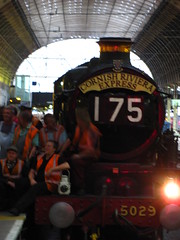
It was first time I met Mathew in person. I had known Mathew for several years prior originally on CoasterSims.com, and when that website folded I went on to create Roller Coaster Philosophy while he developed the NoLimits-Exchange. It was always an option that when I would visit the UK we could meet up, and when I found out that he had never been on a wooden roller coaster before, I vehemently insisted that he join me for Oakwood. Although he was very busy with further developments of his website, he had been wanting to do a least one theme park new to him that year, and the dates and prices were workable so he agreed; and now here we were at Paddington Station chatting coasters and NoLimits waiting for our late 22:45 train to Swansea to depart. (By the way, Mathew keeps in contact with NoLimits developer Ole Lange and he was able to share a few juicy details about the upcoming NoLimits 2 that he swore me to secrecy; I’ll continue to honor it, although I’m so late with this review that most of what I recall from our conversation would be old news anyway.)
 Ironically it was not the first time I had spent the night in a train station in Wales: the first time was in Holyhead on my way back from Ireland. This was the primary concern of Mathew regarding the trip, but it was the only way to get us there on time for a full day while eliminating any hotel expenses. We arrived a little before 2:30am and would depart at 5:50 for the final leg to Narberth. As soon as we walked off the train I had a quick scour of the place, found a spot against the wall, settled down with my backpack as a pillow and was ready to catch some z’s, somewhat to the surprise of Mathew who found the location wholly untenable for sleep and so wandered the station for some time figuring he could forego sleep for the entire day. If any spectators were present it would have been quite obvious which one of us
Ironically it was not the first time I had spent the night in a train station in Wales: the first time was in Holyhead on my way back from Ireland. This was the primary concern of Mathew regarding the trip, but it was the only way to get us there on time for a full day while eliminating any hotel expenses. We arrived a little before 2:30am and would depart at 5:50 for the final leg to Narberth. As soon as we walked off the train I had a quick scour of the place, found a spot against the wall, settled down with my backpack as a pillow and was ready to catch some z’s, somewhat to the surprise of Mathew who found the location wholly untenable for sleep and so wandered the station for some time figuring he could forego sleep for the entire day. If any spectators were present it would have been quite obvious which one of us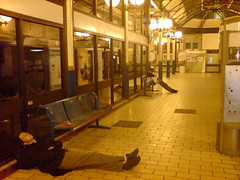 had just come from a long day of professional tennis after six months of travel including three prior nights spent in far worse train station conditions, and which one was the computer nerd night owl who had spent the previous week sleeping in in his own bed at home.
had just come from a long day of professional tennis after six months of travel including three prior nights spent in far worse train station conditions, and which one was the computer nerd night owl who had spent the previous week sleeping in in his own bed at home.
We arrived in Narberth with nearly three hours of time to kill before the park would open its gates, where we decided we could save more money by using our excess time to walk to Oakwood rather than take the recommended route by taxi to cover the five miles (for some reason there is absolutely no bus service to or from the train station to Oakwood so you’re stuck taking a taxi, a rather expensive proposition especially if it was to be a round-trip for only one person). We had made a quite good distance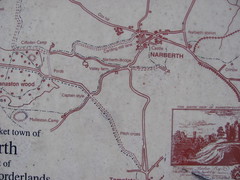 into the countryside when we both concluded that we had a vague idea of the direction we should have been moving towards and neither of us had actually brought any more accurate maps or directions beyond that. Just as Mathew was calling up his parents to see if they could look up directions for us, a lady in a red sports car pulled up, rolled down her window and asked if we boys needed a lift. We had a brief exchange and deliberation over whether this was a good idea for everyone involved (she was on her way to work and Oakwood was in the opposite direction), but as we needed to make up our minds quickly we decided we couldn’t turn down the request, and very soon we were speeding through the country roads on our way to a day of roller coasters. It quite shocked her as to why anyone would come all the way from London
into the countryside when we both concluded that we had a vague idea of the direction we should have been moving towards and neither of us had actually brought any more accurate maps or directions beyond that. Just as Mathew was calling up his parents to see if they could look up directions for us, a lady in a red sports car pulled up, rolled down her window and asked if we boys needed a lift. We had a brief exchange and deliberation over whether this was a good idea for everyone involved (she was on her way to work and Oakwood was in the opposite direction), but as we needed to make up our minds quickly we decided we couldn’t turn down the request, and very soon we were speeding through the country roads on our way to a day of roller coasters. It quite shocked her as to why anyone would come all the way from London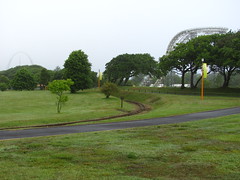 just for a small park like Oakwood, and so I let Mathew do most of the explaining as I was afraid I might cause her to hernia if she knew her other passenger crossed an entire ocean to be there, which at the very least would have been a bad thing to happen while driving. Dropping us off at the main entrance in a very empty parking lot, she told us to write good things about Oakwood and Wales to the other coaster enthusiasts when we get back to London as they could definitely use the extra tourism. We agreed we would and thanked her profusely for her kindness as she once again sped off into the horizon. Now we just had two hours to kill before the park would open for business.
just for a small park like Oakwood, and so I let Mathew do most of the explaining as I was afraid I might cause her to hernia if she knew her other passenger crossed an entire ocean to be there, which at the very least would have been a bad thing to happen while driving. Dropping us off at the main entrance in a very empty parking lot, she told us to write good things about Oakwood and Wales to the other coaster enthusiasts when we get back to London as they could definitely use the extra tourism. We agreed we would and thanked her profusely for her kindness as she once again sped off into the horizon. Now we just had two hours to kill before the park would open for business.
It was the first time in Europe I had ever arrived at a park significantly before it began operations.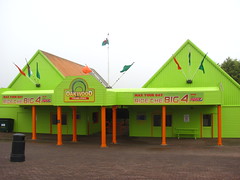 I continue to hold a belief long instilled by Discovery Channel documentaries about Cedar Point or Disneyland that the opening procedures of a park are a long, involved process involving workers to arrive long before daybreak so they can check and clean every part on every ride, while meanwhile the guests camp outside the entrance for hours in a desperate bid to be the first one in line for the major attractions when they open. To put it simply, that’s not the story at Oakwood. We sat for the majority of those two hours aware that we were probably the only two souls to be found within a couple miles’ radius, and it wasn’t until less than 45 minutes to opening that a few employee cars finally trickled in, relaxing our suspicion that we may have been set up to endure a Clark Griswold. Fifteen minutes to opening a few actual customers showed up to join us in our wait.
I continue to hold a belief long instilled by Discovery Channel documentaries about Cedar Point or Disneyland that the opening procedures of a park are a long, involved process involving workers to arrive long before daybreak so they can check and clean every part on every ride, while meanwhile the guests camp outside the entrance for hours in a desperate bid to be the first one in line for the major attractions when they open. To put it simply, that’s not the story at Oakwood. We sat for the majority of those two hours aware that we were probably the only two souls to be found within a couple miles’ radius, and it wasn’t until less than 45 minutes to opening that a few employee cars finally trickled in, relaxing our suspicion that we may have been set up to endure a Clark Griswold. Fifteen minutes to opening a few actual customers showed up to join us in our wait. Ten o’clock rolled around, and at long last the ticket booths opened and the chain was dropped, and we were off running to… well, first you have to take a miniature train to get from the entrance to the rest of the park, a quaint, charming feature to ‘transport’ guests into the grassy green thrill ride playground that is Oakwood. But once we got off the train, the race resumed to… oh, but I had to find the gift shop where they had a stored luggage service for my backpack… but after that we ran, err, well, walked (but with a bit more forward spring in our steps than one normally would have when walking to McDonalds five minutes before their breakfast menu is taken down) to our first ride of the day.
Ten o’clock rolled around, and at long last the ticket booths opened and the chain was dropped, and we were off running to… well, first you have to take a miniature train to get from the entrance to the rest of the park, a quaint, charming feature to ‘transport’ guests into the grassy green thrill ride playground that is Oakwood. But once we got off the train, the race resumed to… oh, but I had to find the gift shop where they had a stored luggage service for my backpack… but after that we ran, err, well, walked (but with a bit more forward spring in our steps than one normally would have when walking to McDonalds five minutes before their breakfast menu is taken down) to our first ride of the day.
This was another first for me: my first decent modern wooden roller coaster in Europe. In the states you can reasonably expect at least one or two first-class woodies regardless of which region you visit, but in Europe I found the offerings of modern lumber runners that I would consider ranking with the best of them wholly absent for me until today (although Germany, Holland and Scandinavia have started sprinkling some quality offerings within the past half decade). This was an even more important first for Mathew, as I already noted he had never before been on a wooden coaster. We originally intended to be the first to the front row, but somehow a large group of young teenagers had already beaten us there so we decided to take the next train in the very last row. Not even I was able to predict at that instant entirely what we
Not even I was able to predict at that instant entirely what we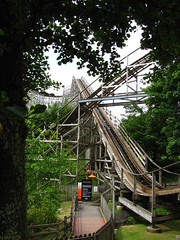 were getting ourselves into.
were getting ourselves into.
They layout is prototypical for original Custom Coasters International designs: sort of a twister configuration but with enough straight airtime hills that it’s maybe better described as a triple out-and-back/figure-eight, with a bit of a terrain element as well. The area around the station and at the bottom of the first drop takes place at the bottom of a small ridge next to a pond where plenty of trees grow, while the majority of the ‘main action’ sits on a cleared green field on top of the hill, which from online photos I always thought appeared to belong to a smaller coaster than the first drop suggested. I also looked but I don’t think the famed sheep grazing underneath the structure were out today.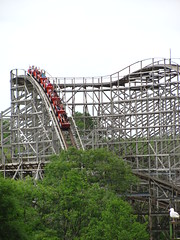
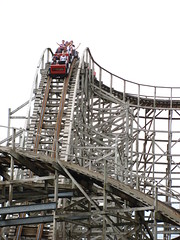
I didn’t get to search for too long because as soon as we crested the lift the front of the train was guiding us through a very narrow turnaround offering a dizzy panoramic view of the Welsh landscape, and then gave Mathew an introduction to the world of wooden roller coasters I don’t think he’ll ever forget. The track very sharply angles down to the maximum 55° angle, and with the first five cars acting as the bullwhip we can literally hear the crack of upstop wheels against steel that signals the commencement of the action. After doing some soul-searching, I came to the conclusion that Megafobia’s back seat offers the strongest and most intense first drop airtime of any wooden roller coaster I’ve ever experienced, and I like to think I’ve been on some good contenders. It’s not even the ordinary force of the airtime itself that makes this important; it was how this brutally shocking wake-up call initiates the breathless ride to follow from a tepid standstill to diving headfirst naked into icy water. There’s not going to be anything wilder than this for the rest of the layout but it doesn’t matter because it’s not meant for normal mortals to endure more than once.
of any wooden roller coaster I’ve ever experienced, and I like to think I’ve been on some good contenders. It’s not even the ordinary force of the airtime itself that makes this important; it was how this brutally shocking wake-up call initiates the breathless ride to follow from a tepid standstill to diving headfirst naked into icy water. There’s not going to be anything wilder than this for the rest of the layout but it doesn’t matter because it’s not meant for normal mortals to endure more than once.
The negative force is sustained for the better fraction of a second (which feels more like three or four whole seconds) before the train bottoms out, which was the only place a bit of jack-hammering could be noticed but even then it wasn’t very detectable towards the front of the train. Otherwise 2010 seemed to be a very good year for Megafobia, which rolled as cleanly as a new brand CCI. (I don’t want to say ‘smoothly’ for a ride that finds an unhinged aggressiveness in the very nature of its layout and runs with PTCs which are supposed to have a bit of slop and shuffle to keep it loose and fast.) It managed to maintain its speed, something fewer CCIs seem able to do so I must commend Oakwood’s maintenance staff, especially as they are rather isolated and have few other parks to exchange techniques or tradesmen with.
for a ride that finds an unhinged aggressiveness in the very nature of its layout and runs with PTCs which are supposed to have a bit of slop and shuffle to keep it loose and fast.) It managed to maintain its speed, something fewer CCIs seem able to do so I must commend Oakwood’s maintenance staff, especially as they are rather isolated and have few other parks to exchange techniques or tradesmen with.
From the curving first drop valley along the pond the train races beneath a large tree and back over the lift and up the ridge into an extended moment of more negative-Gs.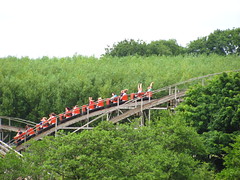 It crests up again for the farthest turn around, one of their dipping bowl curves in typical CCI fashion. There’s a series of more airtime hills punctuated by more hard lateral turns, crossing back and forth the plot of land twice more before veering off through the trees along the hill and back into the brakes.
It crests up again for the farthest turn around, one of their dipping bowl curves in typical CCI fashion. There’s a series of more airtime hills punctuated by more hard lateral turns, crossing back and forth the plot of land twice more before veering off through the trees along the hill and back into the brakes. The exact sequence of hills and turns isn’t all that important; there are POV videos if you want to see for yourself. Layout progression isn’t present except for in the most general of ways. Variation does exists and is an important ingredient to keeping the ride fresh with a few unique benchmark moments scattered throughout, not that these are anything other than random occurrences. My two most memorable: one of the last bunny hops has an evil little left-hand jolt hidden just behind the apex of one of the last bunny hops, and how a 180° turnaround under the lift hill, otherwise the slowest paced part of the ride, stops for a small straight stretch of track in the middle of it due to the way it traces along the dominating structure (obviously not a thrilling or even artistic feature, just a little quirk that gives it personality and always made me smile).
The exact sequence of hills and turns isn’t all that important; there are POV videos if you want to see for yourself. Layout progression isn’t present except for in the most general of ways. Variation does exists and is an important ingredient to keeping the ride fresh with a few unique benchmark moments scattered throughout, not that these are anything other than random occurrences. My two most memorable: one of the last bunny hops has an evil little left-hand jolt hidden just behind the apex of one of the last bunny hops, and how a 180° turnaround under the lift hill, otherwise the slowest paced part of the ride, stops for a small straight stretch of track in the middle of it due to the way it traces along the dominating structure (obviously not a thrilling or even artistic feature, just a little quirk that gives it personality and always made me smile).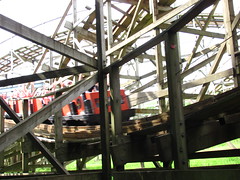
What’s important is that the layout is long and complicated enough that it’s hard to memorize the entire thing without many, many rerides. The joy stems from being strung along on a ride that never seems to lose pace while it paints in forces using big, bold brushstrokes. The color palate is much more limited than what would later be seen on GCI or Gravity Group coasters; the forces are generally in the same range of sharp negatives and punishing laterals, and there isn’t much crossover between the two. The newer designers like to mix their forces with dynamically changing turns that lead into pops of airtime, producing an ever-shifting spectrum of force that can sometimes be hard to pin down what exactly is going on. When Megafobia paints in blue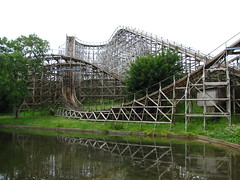 or yellow, you clearly see that color and can also see exactly where the borders are. The transitions between forces are very sudden and sometimes jarring, a quality Mathew commented as seeming rough to him (his sole criticism of the ride), but for me this is exactly what makes CCI so distinctive. Even when the layout’s reached a bit of a slow spot, it talks to me in a way that seems to be missing from later designs.
or yellow, you clearly see that color and can also see exactly where the borders are. The transitions between forces are very sudden and sometimes jarring, a quality Mathew commented as seeming rough to him (his sole criticism of the ride), but for me this is exactly what makes CCI so distinctive. Even when the layout’s reached a bit of a slow spot, it talks to me in a way that seems to be missing from later designs.
When we got off I was quite confident I would rank it on my lists very highly, but shied away from considering top designations because I do like a layout with progression, pacing variations with a sense of dramaturgy, and a singular, rock solid identity… traits found among CCI’s own canon such as the Raven or Shivering Timbers, but not here. However for ‘Classic Mold CCI’ it’s at the top of its class, at least when judging it in 2010 when so many of Megafobia’s once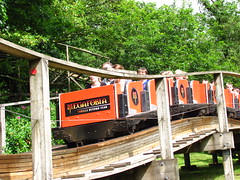 highly esteemed contemporaries seem unable to hold their speed to the end if they’re even able to prevent unnecessary roughness. I walked down the exit ramp feeling elated that it met (though did not exceed) every expectation I had for what a great ride of its ilk should be. I must not have acted it because Mathew, after a short excited appraisal of the coaster’s many positive traits, commented that I sounded as if I were a bit disappointed with Megafobia.
highly esteemed contemporaries seem unable to hold their speed to the end if they’re even able to prevent unnecessary roughness. I walked down the exit ramp feeling elated that it met (though did not exceed) every expectation I had for what a great ride of its ilk should be. I must not have acted it because Mathew, after a short excited appraisal of the coaster’s many positive traits, commented that I sounded as if I were a bit disappointed with Megafobia.
“Oh. No, believe me, I did really like it,” I said. “I guess after so many months of doing this it’s just harder for me to show it.”
We ambled down the pathway as we further discussed our thoughts on Megafobia when we nearby uncovered what was to be another first for me: the Bobsleigh, my first-ever alpine slide. I realize these things are pretty ubiquitous so it surprises even me that my first encounter with one wouldn’t have been until now, although I guess they’re not normally considered theme park essentials and as I normally have my hands full with theme parks and don’t need to go to ski resorts or the like it’s understandable. The concept is simple and sure to please coaster enthusiasts: you sit in a small plastic sled on wheels with a small friction pad brake lever in front you use to control your speed as you’re sent down a winding steel trough along a small hillside in the center of the park. There’s a cable lift at the beginning (the lift track is a narrow side-friction channel with a dug-out center so you can relax the brake lever and not have it catch on anything… yes, I know only nerds
to be another first for me: the Bobsleigh, my first-ever alpine slide. I realize these things are pretty ubiquitous so it surprises even me that my first encounter with one wouldn’t have been until now, although I guess they’re not normally considered theme park essentials and as I normally have my hands full with theme parks and don’t need to go to ski resorts or the like it’s understandable. The concept is simple and sure to please coaster enthusiasts: you sit in a small plastic sled on wheels with a small friction pad brake lever in front you use to control your speed as you’re sent down a winding steel trough along a small hillside in the center of the park. There’s a cable lift at the beginning (the lift track is a narrow side-friction channel with a dug-out center so you can relax the brake lever and not have it catch on anything… yes, I know only nerds would care about that), then there’s a series of about six turns before the signs and a slit curtain tell you to slow down for the final curve back to the station.
would care about that), then there’s a series of about six turns before the signs and a slit curtain tell you to slow down for the final curve back to the station.
I’ll be honest, I was completely smitten with this ride. So much fun,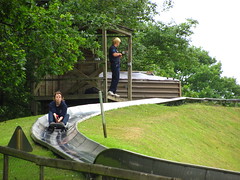 I only wish it could be longer. Something about the high level of exposure, close ground hugging track and ability to pilot your own experience made re-riding addictive. It took me several tries before I had the courage to let it go full speed, which of course I finally decided to test out on my last ride of the day when I also smartly decided to take my camera out to collect the footage below.
I only wish it could be longer. Something about the high level of exposure, close ground hugging track and ability to pilot your own experience made re-riding addictive. It took me several tries before I had the courage to let it go full speed, which of course I finally decided to test out on my last ride of the day when I also smartly decided to take my camera out to collect the footage below.
We wandered some more to get a feel for the layout and see what else would be worth our while during the day. Hydro was closed until later in the afternoon so I casually suggested that maybe we quickly stop in the children’s and give their small Pinfari Clown Coaster a whirl. Mathew groaned.
“You whore. You dirty, dirty credit whore.”
I sheepishly grinned, noting that, “sometimes, especially in small parks, children’s coasters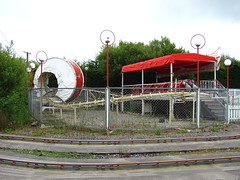 can be one of the better rides on offer. You won’t know until you at least try.”
can be one of the better rides on offer. You won’t know until you at least try.”
One glance at the sorry rusting oval track in question quickly revealed that was unlikely to be the case, so perhaps I would have been better off replying that his coaster count needed the credit far more desperately than I. (Okay, definitely not the right thing to say!) It didn’t matter anyway because it was not in operation, and the nearby attendant explained to us that they can’t operate it on days with wet weather due to low friction problems with the tire drive lift. Listening to his accent, I inquired where he was from. Huntsville, Alabama was his reply. After a short conversation Mathew leaned over to me to note that we Yanks were taking over the whole place. At least it was a distraction from the issues of coaster prostitution.
We stopped for an early lunch in one of Oakwood’s food outlets, nothing special, just a pretty bland burger and chips for both of us. Or, as Mathew corrected me, “burger and fries”. I was a bit taken aback by this because here I thought the potato food substance I called fries were really called chips, and what I called chips were really called crisps, and was careful not to make any mistakes since I arrived. Yet as Mathew explained, ‘chips’ only refers to the large, thick-cut chunks of potato; the narrow, crispy fast food style deep fried potatoes are still fries. This made some degree of sense, but I wondered if the classification could really be as bifurcated as that. Certainly there’s a wide continuous range of fry (or chip) shapes and sizes, where does one draw the cutoff between chip and fry? We have steak fries, shoestring fries, curly fries, waffle fries, crinkle cut fries, sweet potato fries, and if you want them really big, plain ol’ deep fried potato wedges.
between chip and fry? We have steak fries, shoestring fries, curly fries, waffle fries, crinkle cut fries, sweet potato fries, and if you want them really big, plain ol’ deep fried potato wedges.
Regardless of what you call it, what better way to let it digest than at -1.3G’s by 97°? Speed: No Limits was next, the second major attraction to appeal to coaster enthusiasts, and though I rather wish the funds could have been used to build another large wooden coaster instead, I have few qualms regarding the 2006 Eurofighter’s quality. Like Megafobia, Speed is an awesome ride. They are both very different experiences yet are the two coasters that offer the most and highest quality airtime for enthusiasts in the entire United Kingdom. Quite easily the best 1-2 coaster combo in the UK.
I wasn’t completely enamored with the appearance of the ride (at least compared to the naturalistic and photogenic Megafobia); the gigantic 115 foot tall lift tower and thick evergreen supports dominating the midway everywhere seem to be at odds with the parks rustic appeal. But situated along the far perimeter in its own cleared field separated by a dense row of trees it doesn’t intrude too much and making would-be riders crane their heads all the way back to see what it does turns out to be an effective means of building anticipation. Only one 8-passenger vehicle was being cycled, although oddly the queue seemed less populated than the 24-passenger Megafobia on opposite ends of the park.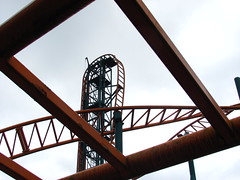
 Speed starts with a tight right turn on a slow approach to the vertical lift, which is quite difficult to see the top of. It stops for a moment on the chain before a latch or something drops to catch it and very quickly we are on our backs and quickly being whisked way up into the sky. The vertical lift is a great way to generate tremendous excitement, as many of the physiological effects (the gravitational weight on your chest makes it harder to breathe or lift your head up to look around, dependency of using the entire seatback for support) translate nicely into psychological byproducts (feelings of domination, helplessness, anxiety, etc), such that when we’re ‘freed’ at the narrow apex we have a somewhat perverse emotional mixture
Speed starts with a tight right turn on a slow approach to the vertical lift, which is quite difficult to see the top of. It stops for a moment on the chain before a latch or something drops to catch it and very quickly we are on our backs and quickly being whisked way up into the sky. The vertical lift is a great way to generate tremendous excitement, as many of the physiological effects (the gravitational weight on your chest makes it harder to breathe or lift your head up to look around, dependency of using the entire seatback for support) translate nicely into psychological byproducts (feelings of domination, helplessness, anxiety, etc), such that when we’re ‘freed’ at the narrow apex we have a somewhat perverse emotional mixture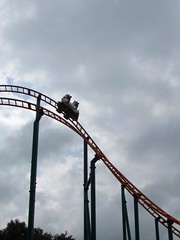 of relief and immediate terror as we threaten to plunge down the other side.
of relief and immediate terror as we threaten to plunge down the other side.
The drop’s almost too sharp and steep, it can be a be a bit difficult to sense exactly how you’re oriented, although at 97° there’s no shortage of negative G’s. The 60 mph pullout is remarkably smooth despite being the tallest and fastest Eurofighter ever built. All the smaller Eurofighters I’ve been on have had some degree of wheel bogey drift that was exacerbated by high speeds, yet Speed glides with grace. I’m not sure what the difference is; possibly the larger layout doesn’t require the chassis to navigate through as sharp or convoluted of curves and thus the wheels are able to grip the rails tighter? Anyway this smoothness is put to more than good use on the next moment, a straight camelback hill filled with huge (and I mean HUGE) airtime. There might be some coasters with stronger airtime, and there might be some with longer airtime, but I bet if you were to plot both criteria of force plus duration on a scatterplot, Speed’s camelback would be one of the farthest outlying points. The force is apparently around -1.3 and this force is sustained for at least two full seconds, which might sound average in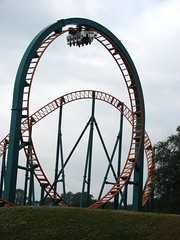 text numericals but is quite a spectacle in real life. I had to be sure to grip my restraint firmly on the pullout of the first drop so it wouldn’t ratchet down on me any further.
text numericals but is quite a spectacle in real life. I had to be sure to grip my restraint firmly on the pullout of the first drop so it wouldn’t ratchet down on me any further.
The power subdues a little bit on the following overbanked turn, which has a pretty wide sweep on the entrance and exit, culminating in a narrower point at the top overbanked by only a few degrees. I can imagine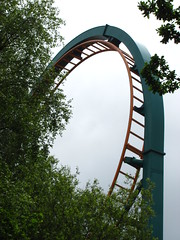 some much more experimental turnarounds that could have filled its place, but the ride so far honestly reminds me of a super-excitable Expedition GeForce so I’m sure few would complain. Gerstlauer deviates from the Intamin megacoaster with the next element, which focuses on the positives rather than the negatives (yet somehow feels less joyful). It’s a straight vertical clothoid loop, absolutely nothing modernized or fancy about it, even the support structure seems to be recalling classic Schwarzkopf design. I’m quite pleased with the simplicity of this element. You feel it and understand what’s going on much easier than the really complicated inversions they like coming up with these days. Plus the uniformly fast pace and sustained high positive Gs match well with the similarly simple but insane negative Gs on the previous camelback.
some much more experimental turnarounds that could have filled its place, but the ride so far honestly reminds me of a super-excitable Expedition GeForce so I’m sure few would complain. Gerstlauer deviates from the Intamin megacoaster with the next element, which focuses on the positives rather than the negatives (yet somehow feels less joyful). It’s a straight vertical clothoid loop, absolutely nothing modernized or fancy about it, even the support structure seems to be recalling classic Schwarzkopf design. I’m quite pleased with the simplicity of this element. You feel it and understand what’s going on much easier than the really complicated inversions they like coming up with these days. Plus the uniformly fast pace and sustained high positive Gs match well with the similarly simple but insane negative Gs on the previous camelback.
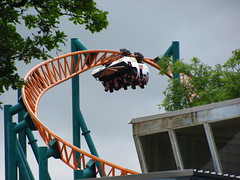 The adrenaline rush drops off precipitously after this first inversion, however, as there’s a long rise into a midcourse block brake (with a rather awkward lefthand shimmy that I’m not sure they got the heartline technique completely right on as I usually got a slight jolt at the top) where the rampaging pace is pretty well sent to die. Instead we get a slow dip into an elevated barrel roll, another element that feels a bit awkward to my sensibilities but at least here that seems an intentional trait by the designers. Also, it has the last moment of negative Gs on the layout in the form of hang-time.
The adrenaline rush drops off precipitously after this first inversion, however, as there’s a long rise into a midcourse block brake (with a rather awkward lefthand shimmy that I’m not sure they got the heartline technique completely right on as I usually got a slight jolt at the top) where the rampaging pace is pretty well sent to die. Instead we get a slow dip into an elevated barrel roll, another element that feels a bit awkward to my sensibilities but at least here that seems an intentional trait by the designers. Also, it has the last moment of negative Gs on the layout in the form of hang-time.
The layout wraps up with a literal wrap up, a swooping left-hand turnaround that peaks into an S-curve into a descending 540° downward helix. This finale is unfortunately rather weak compared to earlier elements doesn’t quite do Speed the justice it fully deserves, not that there’s anything necessarily bad with it per se. One thing I do like about it is that it’s attractive from off-ride with a unique teepee style support structure. As soon as this is over we slide into the magnetic brakes and slink around back to the station. Overall it’s a very good thrill ride, though with the lackluster ending and somewhat brief ride time it still measures up a little bit short to Megafobia, not that there’s any appropriate reason to compare them besides their geographical proximity. Speed is one of those coasters where it amounts to nothing more than the sum of its individual elements, but that’s hardly a problem provided it has some truly superb elements, which it does.
weak compared to earlier elements doesn’t quite do Speed the justice it fully deserves, not that there’s anything necessarily bad with it per se. One thing I do like about it is that it’s attractive from off-ride with a unique teepee style support structure. As soon as this is over we slide into the magnetic brakes and slink around back to the station. Overall it’s a very good thrill ride, though with the lackluster ending and somewhat brief ride time it still measures up a little bit short to Megafobia, not that there’s any appropriate reason to compare them besides their geographical proximity. Speed is one of those coasters where it amounts to nothing more than the sum of its individual elements, but that’s hardly a problem provided it has some truly superb elements, which it does.
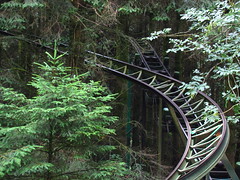 Mathew loved Speed as well, but he found his stamina for it wore thin very quickly so we had to move on after a couple of rides. Back under the dense canopy of Oakwood woods was the final roller coaster I would tick of my list in Europe, the Treetops Coaster. This is a basic large Tivoli coaster that should be well-familiar to any European coaster traveler, but made novel
Mathew loved Speed as well, but he found his stamina for it wore thin very quickly so we had to move on after a couple of rides. Back under the dense canopy of Oakwood woods was the final roller coaster I would tick of my list in Europe, the Treetops Coaster. This is a basic large Tivoli coaster that should be well-familiar to any European coaster traveler, but made novel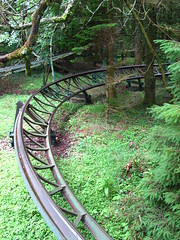 by the dense forest of trees that have grown up around the structure in the over 20 years since its debut. Factor in a dark forest green paint job and despite otherwise being a compact children’s coaster, it virtually disappears from
by the dense forest of trees that have grown up around the structure in the over 20 years since its debut. Factor in a dark forest green paint job and despite otherwise being a compact children’s coaster, it virtually disappears from eyesight any further than fifteen meters beyond the station platform. The ride was the normal collection of curves offering a few laterals with an overlong train, but sitting in the back row and unable to even see the lead car through the foliage made for a slightly unreal experience. I would not recommend anyone raising their arms unless they are wearing gardening gloves.
eyesight any further than fifteen meters beyond the station platform. The ride was the normal collection of curves offering a few laterals with an overlong train, but sitting in the back row and unable to even see the lead car through the foliage made for a slightly unreal experience. I would not recommend anyone raising their arms unless they are wearing gardening gloves.
Nearby was their tower ride Bounce, which along with Megafobia, Speed and Hydro constitutes the last of Oakwood’s much touted “Big Four”, supposedly a challenge to thrillseekers from the marketing department we weren’t going to pass up. Granted the name Bounce doesn’t sound very edgy, in fact it sounds more like a toned down Frog Hopper. And that’s more or less what it is. This is the first tower I’ve seen manufactured by HUSS, who appear to be copying S&S but with a larger tower frame allowing for six seats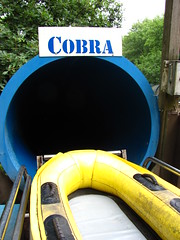 on each face of the shaft, which helped keep lines short. What kept it shortest, however, was the fact that no one wanted to actually ride this thing, so listless was its cycle it acted as little more than an observation tower for the nearby trees. I wouldn’t even call it a drop tower, which is why I dispensed with my normal practice of telling an unrelated joke in place of a review for those rides.
on each face of the shaft, which helped keep lines short. What kept it shortest, however, was the fact that no one wanted to actually ride this thing, so listless was its cycle it acted as little more than an observation tower for the nearby trees. I wouldn’t even call it a drop tower, which is why I dispensed with my normal practice of telling an unrelated joke in place of a review for those rides.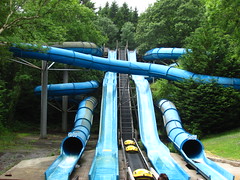
We found a waterslide named the Waterfall that looked like it would offer a bit of fun so we agreed to try it out. It consisted of two straight, open air slides, and two longer winding enclosed slides. Our prediction that they would be fun was correct, especially because the enclosed slides were very dark which hid surprise splashes quite well. It was still a predominantly dry experience, of which the same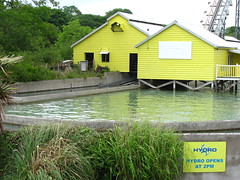 cannot be said of Oakwood’s other major water attraction, Hydro, that had finally opened for the day at 2:00pm.
cannot be said of Oakwood’s other major water attraction, Hydro, that had finally opened for the day at 2:00pm.
With Hydro I found myself in a rather cynical paradox. One the one hand, I knew that if I rode it I would regret the decision immensely, likely to get soaked from head to toe in a way that might be acceptable if this were Buena Park, California, but not Pembrokeshire, Wales. Yet on the other hand, if I were to not ride (as Mathew decided was his best course of action), I knew that I would also regret the decision immensely once the day was over, as it was simply too large and important an attraction (arguably on the same scale as Speed and Megafobia) for me to pass up the opportunity. Why did Oakwood have to build this, why?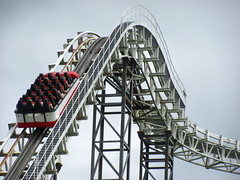 Wouldn’t a nice roller coaster have served their purposes just as well?
Wouldn’t a nice roller coaster have served their purposes just as well?
Hydro is an Intamin Mega Splash ride, one of only two in the world along with Knott’s Berry Farm’s original Perilous Plunge. The idea at the time seemed quite radical, which was to take a super-steep drop profile only seen on megacoasters like Millennium Force and apply it to a shoot-the-chutes flume ride to get an even bigger splash. The ride gain notoriety in 2004 when a 15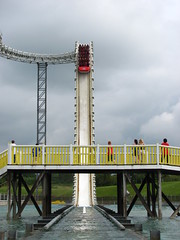 year old girl died after falling out of it, resulting in a lengthy closure where it reopened a year later with the lapbars replaced with over-the-shoulder harnesses. I was
year old girl died after falling out of it, resulting in a lengthy closure where it reopened a year later with the lapbars replaced with over-the-shoulder harnesses. I was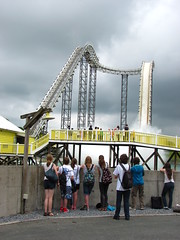 grateful for the new restraints, if only because they provide just a little bit more shelter from downpouring water on the splashdown. I had my jacket with me which I wore hood up, zipped tight, and every button buttoned and snap snapped, and my trousers rolled completely up to my knees with my socks stuffed deep in my pockets I doubtlessly looked more than a bit silly, but I’m certain everyone else waiting in line understood my fashion sense perfectly.
grateful for the new restraints, if only because they provide just a little bit more shelter from downpouring water on the splashdown. I had my jacket with me which I wore hood up, zipped tight, and every button buttoned and snap snapped, and my trousers rolled completely up to my knees with my socks stuffed deep in my pockets I doubtlessly looked more than a bit silly, but I’m certain everyone else waiting in line understood my fashion sense perfectly.
 If the ride looks like a simple premise from the ground, that’s because it is. They load me in (I ended up in the back row center), set me off, the lift hill takes its sweet time, where I finally roll off the top on a dry 180° turnaround, then plunge straight down at around 75° with some of the show water kicking up over me, I brace myself while trying to cover up the exposed pant material I still have, and then all I hear is the enormous, crushing “whoosh” of the wall of water kicking up from the lead of the boat accompanied by a sudden deceleration. There’s a second or two where I think I might be okay… and then the swimming pool the raft shot into the air returns
If the ride looks like a simple premise from the ground, that’s because it is. They load me in (I ended up in the back row center), set me off, the lift hill takes its sweet time, where I finally roll off the top on a dry 180° turnaround, then plunge straight down at around 75° with some of the show water kicking up over me, I brace myself while trying to cover up the exposed pant material I still have, and then all I hear is the enormous, crushing “whoosh” of the wall of water kicking up from the lead of the boat accompanied by a sudden deceleration. There’s a second or two where I think I might be okay… and then the swimming pool the raft shot into the air returns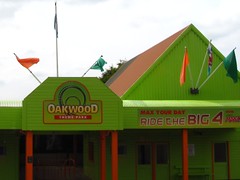 to earth, landing squarely on top of me. I actually fared quite well all things considered, although any less caution taken with my attire would have had me singing a very different tune. Even looking back on it nearly a year later I’m not certain it was really worth it, but like Édith Piaf I can’t say I have any regrets.
to earth, landing squarely on top of me. I actually fared quite well all things considered, although any less caution taken with my attire would have had me singing a very different tune. Even looking back on it nearly a year later I’m not certain it was really worth it, but like Édith Piaf I can’t say I have any regrets.
The discerning reader may have noticed that the categorization and title of this report says “Oakwood Leisure Park”, even though the park has not referred to itself as such in several years, instead adapting the moniker “Oakwood Theme Park”. This was a very deliberate choice. For me, Oakwood will always be a Leisure Park, never a Theme Park. For one thing, that’s because it’s not a theme park. Apart from some children’s sections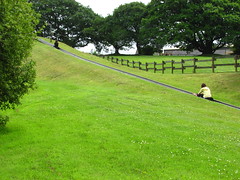 there are no themed attractions or settings anywhere. But more importantly,
there are no themed attractions or settings anywhere. But more importantly, I want them to keep it that way. I’ve noticed a trend among British parks in which their marketing people seem to think “amusement park” (or like-minded variants) is a dirty word. It has to be called a “theme park” otherwise you’re old and redundant. Theme parks are what Alton Towers and Disneyland are. Everyone should aspire to the same level of quality as they, right? New Flash: you’re not Alton Towers or Disneyland. Don’t try to be if it means cannibalizing those parts of your heritage that provided your distinctive cultural identification. “Ah yes, Leisure Park, that place in Wales with the awesome wooden coaster and the sheep under it!”
I want them to keep it that way. I’ve noticed a trend among British parks in which their marketing people seem to think “amusement park” (or like-minded variants) is a dirty word. It has to be called a “theme park” otherwise you’re old and redundant. Theme parks are what Alton Towers and Disneyland are. Everyone should aspire to the same level of quality as they, right? New Flash: you’re not Alton Towers or Disneyland. Don’t try to be if it means cannibalizing those parts of your heritage that provided your distinctive cultural identification. “Ah yes, Leisure Park, that place in Wales with the awesome wooden coaster and the sheep under it!”
 Oakwood’s offense is mostly limited to the front gate, which is probably the most blatantly malapropos use of the “Theme Park” meme because the park is still patently without a theme while it came at the expense of a far more personal name. But the trend seems to have not escaped a single park on the isles outside of the fashionably unfashionable Great Yarmouth. There’s Blackpool’s unfortunate appropriation of corporate franchises as the only way to salvage themselves from the neglect of time with their new Nick Land; M&D’s rather inexplicable usage of the term despite being not much more than a carnival ride dumping ground; and Fantasy Island’s admirable but unsuccessful attempts to overlook the fact that they’re located in one of the ugliest spots on Earth; among others. The park I’m most concerned about
Oakwood’s offense is mostly limited to the front gate, which is probably the most blatantly malapropos use of the “Theme Park” meme because the park is still patently without a theme while it came at the expense of a far more personal name. But the trend seems to have not escaped a single park on the isles outside of the fashionably unfashionable Great Yarmouth. There’s Blackpool’s unfortunate appropriation of corporate franchises as the only way to salvage themselves from the neglect of time with their new Nick Land; M&D’s rather inexplicable usage of the term despite being not much more than a carnival ride dumping ground; and Fantasy Island’s admirable but unsuccessful attempts to overlook the fact that they’re located in one of the ugliest spots on Earth; among others. The park I’m most concerned about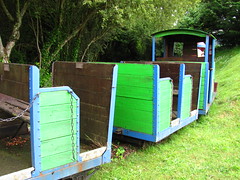 however is Lightwater Valley, whose recent efforts to expand and improve themselves as best as their few profit margins will allow (and God bless ‘em for that) seems to be married to the belief that they should transform themselves into a themed park in the process. Please. Don’t.
however is Lightwater Valley, whose recent efforts to expand and improve themselves as best as their few profit margins will allow (and God bless ‘em for that) seems to be married to the belief that they should transform themselves into a themed park in the process. Please. Don’t.
The original purpose of themeing was to enhance the visual aesthetic qualities of a park, yet does anyone really believe that the natural green landscapes of these parks are enhanced by arbitrary foam pirate ships dotting the foreground? Removed of the theme park culture we would almost surely be disgusted by the faux tackiness of these props, yet not only do parks build them, the visitors demand it. This goes beyond a criticism of mere business practices (themeing, no matter how misplaced, does seem to consistently invite praise and turn a profit, so there’s no argument there) and into a much larger social critique.
does seem to consistently invite praise and turn a profit, so there’s no argument there) and into a much larger social critique.
The façade is no longer an object of shallow beautification. On the surface it can represent anything, it doesn’t matter. We see through it instantly that the willfulness to deceive is not even a purpose anymore. All that matters is that we know it is there. The ‘theme’ always remains the same, and the ‘theme’ is this: Money. Class. Goodness. Authenticity is vulgar. The amusement parks, leisure parks and pleasure beaches only reflect the national identity as it really is, not how it wants to be seen. An attempt therefore must be made to mask it, which is to ‘better’ it. Like a celebrity in an infomercial no intrinsic value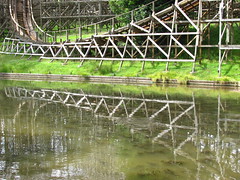 is added, it’s just a way to prove your product is respectable and you have deep pockets. That is the direction the British theme park industry appears to this outside spectator to be evolving.
is added, it’s just a way to prove your product is respectable and you have deep pockets. That is the direction the British theme park industry appears to this outside spectator to be evolving.
That is not what I want to see, but then again I’m a damn tourist. I want to pay to watch other cultures frozen behind glass. The multiculturalist can’t exist if everyone else isn’t a monoculturist tied to a heritage they would maybe rather distance themselves from. Maybe my conception of what a Leisure Park is really is dead, and flashy, edgy phoniness is the new authentic reality for Great Britain. I don’t know. Fuck it. I just want one last ride in the back row of a pretty damn fine wooden roller coaster before I go home.
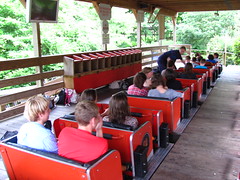
Comments